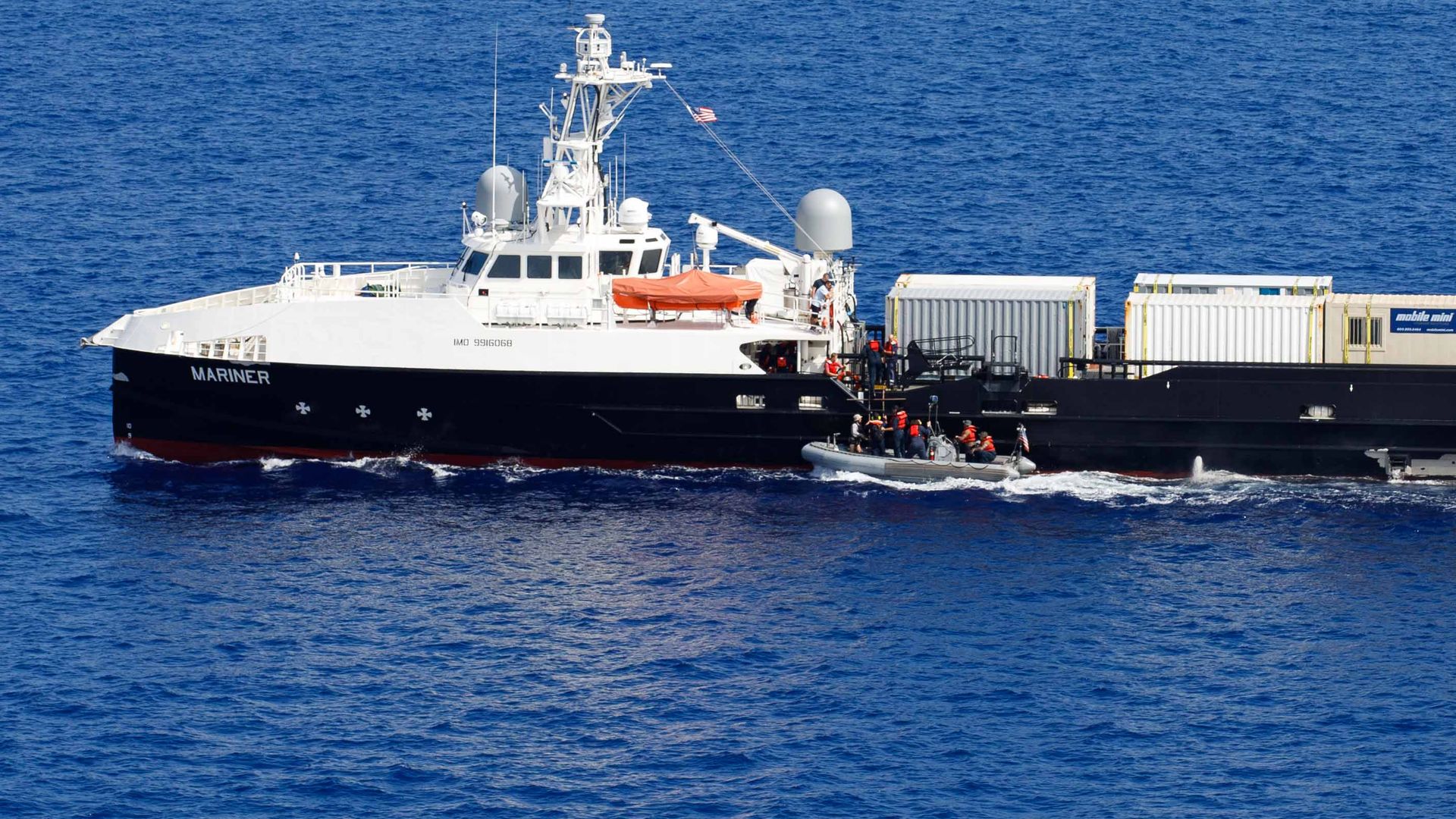
WHETHER BY SEA, AIR OR LAND, THE UNITED STATES AND ITS ALLIES IN THE PACIFIC ARE GOING TO GREAT LENGTHS TO DETER CHINA AND NORTH KOREA FROM UPSETTING THE BALANCE OF POWER IN THE REGION.
A LARGE PART OF THE STRATEGY AGAINST CHINA INVOLVES USING UNMANNED VEHICLES, INCLUDING WHAT THE NAVY CALLS UNMANNED SURFACE VESSELS, OR USVs. THE US NAVY NOW HAS TWO MULTI-ROLE USVs AT A BASE IN JAPAN: THE MARINER AND THE RANGER.
BOTH VESSELS ARE PART OF THE NAVY’S GHOST FLEET OVERLORD PROGRAM. THE EXPERIMENTAL USVs WERE ORIGINALLY DESIGNED TO BE TRANSPORT SHIPS, BUT WERE THEN OUTFITTED WITH DIFFERENT RADARS, SENSORS, AND OTHER TECH TO HELP THE NAVY DETERMINE THE BEST WAY TO INTEGRATE AUTONOMOUS SURFACE VESSELS INTO ITS FLEET.
BOTH THE MARINER AND RANGER RECENTLY PARTICIPATED IN SEVERAL MILITARY DRILLS, INCLUDING LARGE SCALE EXERCISE 2023, WHICH WE REPORTED ON BEFORE. THE MARINER IS THE NEWER OF THE TWO USVs. THE 194-FOOT-LONG VESSEL USES FIVE 2,000 HORSEPOWER DIESEL ENGINES THAT DRIVE FIVE WATER JETS.
REDUNDANCY ON UNMANNED VESSELS IS MORE IMPORTANT THAN CREWED SHIPS. SO, THE USVs HAVE THREE GENERATORS ON BOARD, ONE OF WHICH IS DEDICATED TO PROVIDING POWER TO THE SHIPS PAYLOAD.
BOTH THE MARINER AND RANGER USE THE NAVY’S AEGIS COMBAT SYSTEM. THEY CAN LINK TO OTHER AEGIS-ENABLED SHIPS IN THE FLEET AND CAN ALSO ACT AS A MOTHERSHIPS FOR OTHER USVs. AND THERE’S ENOUGH DECK SPACE TO MOUNT ALL SORTS OF LAUNCHERS, LASERS, AND OTHER NAVAL WEAPONRY.
NOW IN THE PACIFIC, THE MARINER AND RANGER ARE WHAT’S KNOWN AS ‘FORCE MULTIPLIERS.’ TWO USVs PAIRED WITH ONE GUIDED MISSILE DESTROYER, FOR EXAMPLE, WILL GIVE THE NAVY THE SAME SURFACE POSTURE AS THREE GUIDED MISSILE DESTROYERS, BUT AT A FRACTION OF THE PRICE BOTH IN TERMS OF DOLLARS AND MANPOWER. MOST OF THE TWO GHOST SHIP’S OPERATIONAL CAPACITY IN JAPAN IS CLASSIFIED, BUT ONE ANALYST SAID THE BOATS ARE LOADED WITH COMBINABLE WEAPONS MODULES LIKE THE NAVY’S STANDARD MISSILE-6, WHICH ARE GOOD FOR AIR DEFENSE, DOWNING BALLISTIC MISSILES, AND EVEN TAKING OUT OTHER ENEMY SURFACE VESSELS.
JAPAN, LIKE THE US, UNDERSTANDS COUNTERING CHINA WILL TAKE MORE THAN SEA POWER, THOUGH. IT WILL LIKELY INCLUDE COUNTERING CHINA’S REGIONAL ALLIES AS WELL. TO FURTHER THAT MISSION, JAPAN’S AIR SELF-DEFENSE FORCES TEAMED WITH THE AIR FORCES FROM THE US AND SOUTH KOREA TO HOLD THE FIRST EVER JOINT EXERCISES BETWEEN THE THREE NATIONS.
THE EXERCISES WERE HELD NEAR THE KOREAN PENINSULA AND INVOLVED FIGHTERS FROM ALL THREE COUNTRIES, AND A U.S. B-52 STRATOFORTRESS STRATEGIC BOMBER. B-52s CAN CARRY NUCLEAR WEAPONS AND ARE A PART OF THE US TRIAD OF STRATEGIC NUCLEAR DETERRENCE. A B-52 LANDING IN SOUTH KOREA IS RARE, AND IT’S AN OBVIOUS SHOW OF FORCE TO NORTH KOREA AND CHINA THAT THE INTEROPERABILITY BETWEEN THE US AND ITS PACIFIC ALLIES IS GROWING.
AND IN ONE OF THE MOST TANGIBLE SIGNS OF THAT GROWING INTEROPERABILITY, THE US ARMY IS NOW KEEPING THREE COMPANY SETS OF EQUIPMENT IN AUSTRALIA. DEFENSE NEWS REPORTS THE SETS ARE PREPOSITIONED STOCK, SO IT’S EQUIPMENT KEPT IN A HIGH-STATE OF READINESS IN CASE IT NEEDS TO BE USED QUICKLY.
THE GOODWILL GENERATED DURING TALISMAN SABRE 2023 MADE IT POSSIBLE FOR THE ARMY TO KEEP EQUIPMENT IN AUSTRALIA. THE ARMY HOPES THE SAME PRACTICE CAN BE DUPLICATED WITH OTHER ALLIES IN THE PACIFIC.







